Cooked bones run the risk of splintering - NEVER feed cooked bones!
Natural food suitable for pets:
- Chicken: whole or any parts (backs, necks, wings, etc. or carcasses after meat has been removed for human consumption)
- Turkey: whole or any parts
- Fish: whole fish, fish heads or canned sardines in water, jack mackerel
- Cornish game hens: whole
- Beef: any cuts
- Oxtail
- Pork: any cuts
- Buffalo, kangaroo, goat, sheep, deer, calf can be sawed into large pieces of meat and bone.
- Rats, mice, rabbits, quail can be fed whole
- Organ meat: liver, lungs trachea, hearts, stomach of ruminants, tripe. Your dog needs organ meat for its high nutrient content. Feed organ meats as 10% of thier diet.
- Raw carrots, bananas, rice, apples, watermelon, strawberries, blueberries.
- Canned/cooked pumpkin
- Eggs, fruit, yogurt, vegetables. Eggs, like bones are a good source of calcium.
AVOID:
- Excessive meat off bones
- Excessive vegetables
- Small pieces of bone
- Cooked bones
- Mineral and vitamin additives
- Processed food
- Excessive starch, bread and pastries
- Onions, chocolate, coffee, grapes, raisins, sultanas, currants
- Milk
- Liver should not be fed more than once a week.
- Offal (stomachs, hearts etc.) should not exceed 50% of the diet.
- Avoid feeding the same meat consistently.
- Avoid a large amount of grain as it has no nutritional value in dog food.
- Feed a healthy dog between 2-4% of it's weight daily (adjust as needed)
- Puppies may require up to 10% of their weight daily during growth.
- Introduce one protein source at a time. Feed chicken for a week, then beef for a week etc. This helps detect allergies.
- Raw meaty bones can be fed frozen. Small carcasses for example rats, mice, birds can be fed frozen with entrails. Larger carcasses should have entrails removed before freezing.
- Feeding bowls are unnecessary: Food will be dragged across the floor so feed pets outside.
- Low-fat game animals, fish and birds provide the best source of food for pets. If using meat from domesticated animals avoid excess fat and bones.
- Feed meat and bone together. Dogs can break their teeth on large knuckle bones if it's not covered in meat.
- Feed meat and bone ration in one piece so that ripping, tearing and gnawing is required. This cleans teeth.
- Table scraps can be 1/3 of their diet. Liquidize scraps, both cooked and raw to increase digestibility.
- Puppies can eat minced chicken at around 6 weeks.
- Puppies get their adult teeth between 4 and 6 months. This is a good time to feed raw meaty bones.
Safe handling!
- Immune compromised individuals should not handle raw meat.
- Use gloves to cut and process meat.
- Thaw out enough meat only for 1-2 meals. Keep the rest frozen.
- Wash your hands after handling meat with soap and hot water.
- Wash all utensils used in preparing dog meals.
- Give your dog a short time to finish its meal and throw away any left overs


